Basic Information
-
Targeting Strategy

-
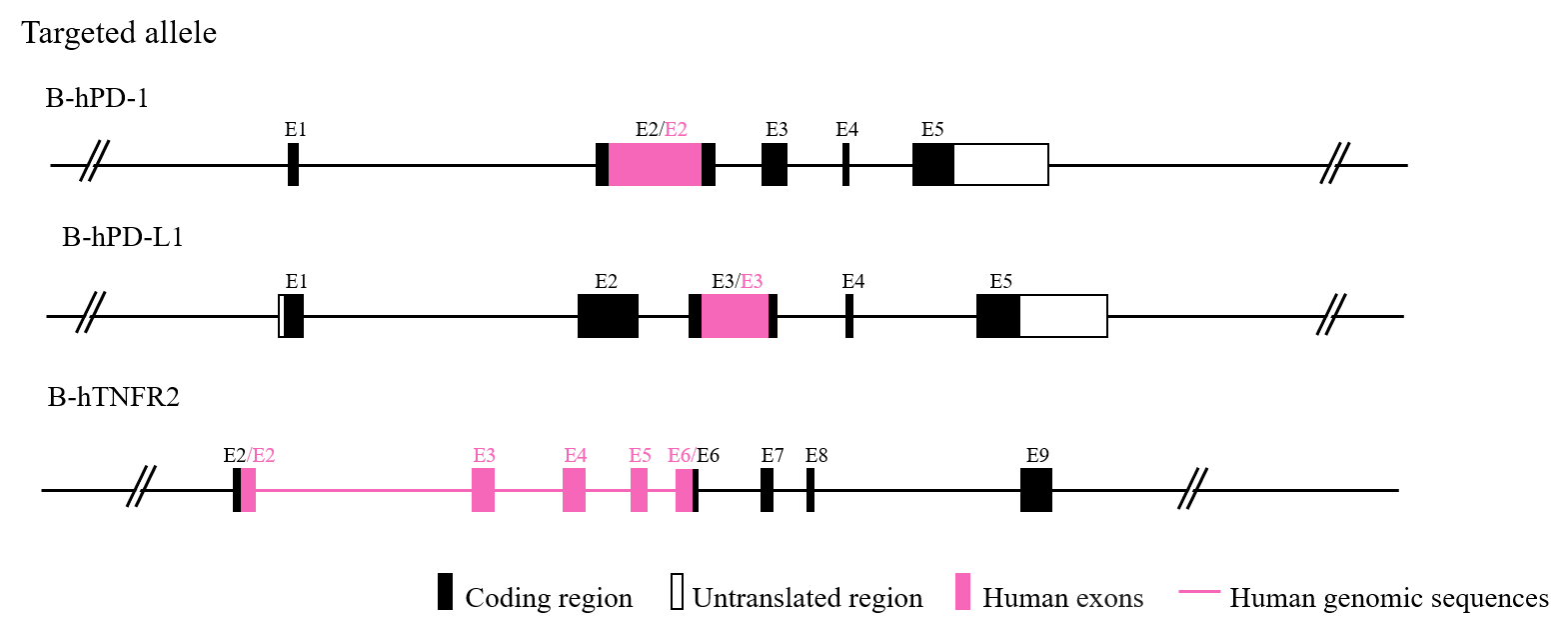
The exon 2 of mouse Pd-1 gene that encodes the extracellular domain was replaced by human PD-1 exon 2 in B-hPD-1/hPD-L1/hTNFR2 mice. The exon 3 of mouse Pd-l1 gene that encodes the extracellular domain was replaced by human PD-L1 exon 3 in B-hPD-1/hPD-L1/hTNFR2 mice. The exons 2~6 of mouse Tnfr2 gene that encode the extracellular domain was replaced by human TNFR2 exons 2~6 in B-hPD-1/hPD-L1/hTNFR2 mice.
-
Protein expression analysis

-
Protein expression analysis in T cells

Strain specific PD-1, PD-L1 and TNFR2 expression analysis in homozygous B-hPD-1/hPD-L1/hTNFR2 (H/H) mice by flow cytometry. Splenocytes were collected from WT and homozygous B-hPD-1/hPD-L1/hTNFR2 (H/H) mice stimulated with anti-CD3ε in vivo, and analyzed by flow cytometry with species-specific anti-PD-1, anti-PD-L1 and anti-TNFR2 antibody. Mouse PD-1, PD-L1 and TNFR2 were detectable in WT mice. Human PD-1, PD-L1 and TNFR2 were exclusively detectable in homozygous B-hPD-1/hPD-L1/hTNFR2 but not WT mice.
-
Immune Cell Profile

-
Analysis of blood leukocytes cell subpopulations in B-hPD-1/hPD-L1/hTNFR2 mice
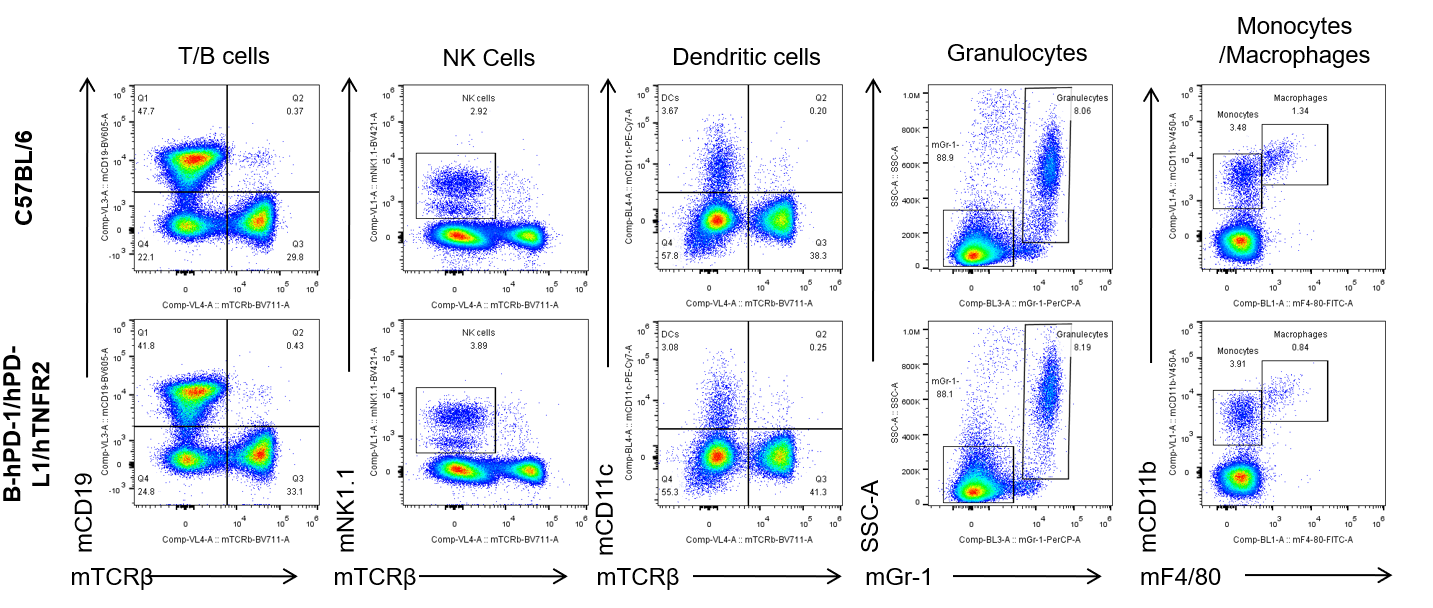
Analysis of spleen leukocytes cell subpopulations in B-hPD-1/hPD-L1/hTNFR2 mice
 Analysis of lymph node leukocytes cell subpopulations in B-hPD-1/hPD-L1/hTNFR2 mice
Analysis of lymph node leukocytes cell subpopulations in B-hPD-1/hPD-L1/hTNFR2 mice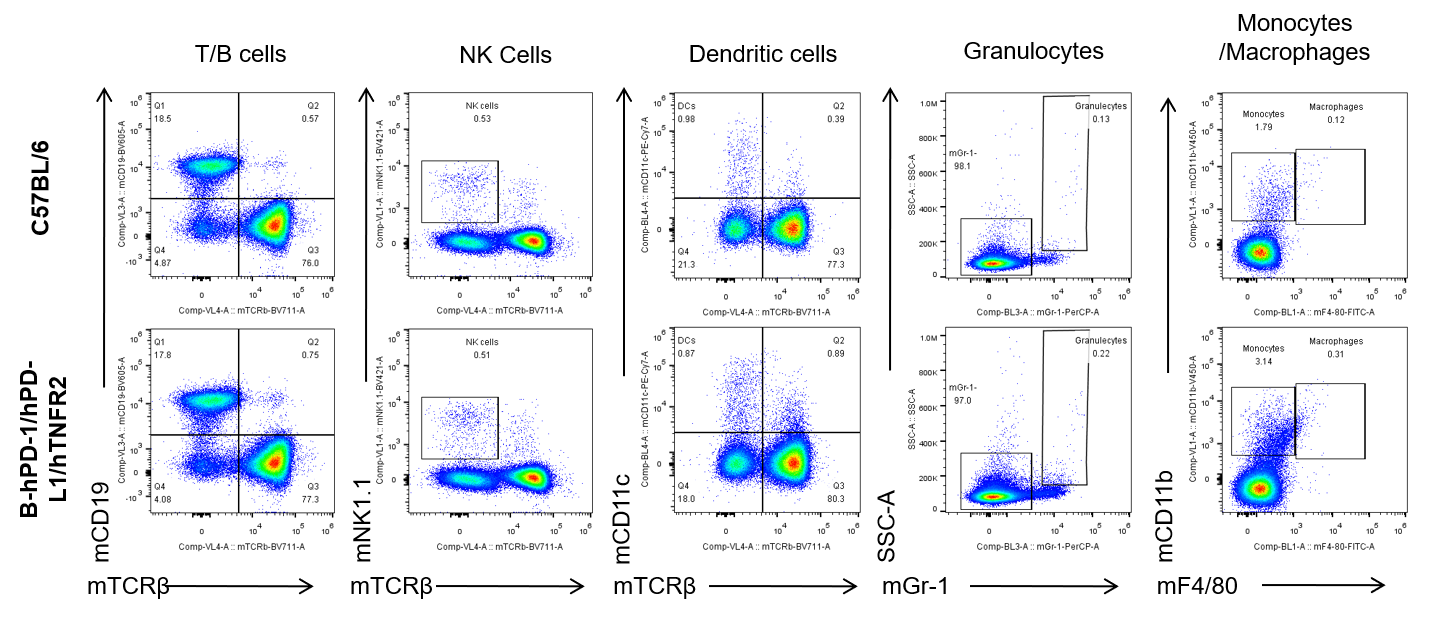
Analysis of blood, spleen and lymph node leukocytes cell subpopulations in B-hPD-1/hPD-L1/hTNFR2 mice
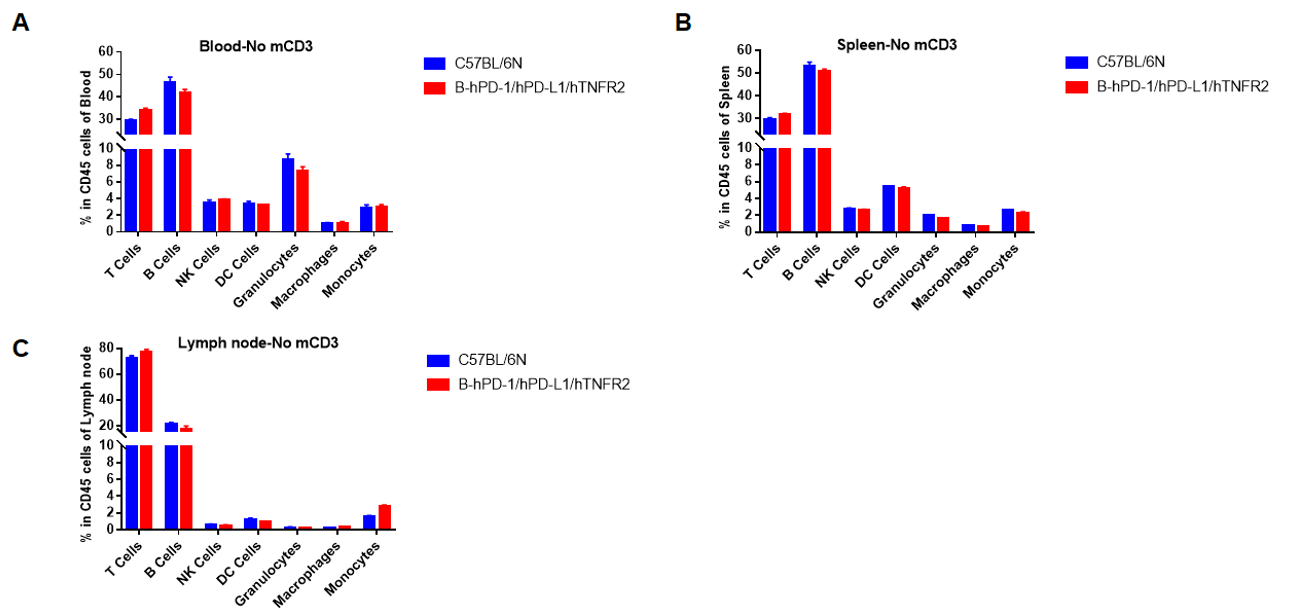
Analysis of blood, spleen and lymph node leukocytes cell subpopulations by FACS
Blood, spleen and lymph node leukocytes cell were isolated from female mice in the panel(n=3, 6 week-old). Flow cytometry analysis was performed to assess leukocyte subpopulations. Percent of T, B, NK, Granulocytes, Monocyte, DC and macrophage cells in homozygous B-hPD-1/hPD-L1/hTNFR2 mice were similar to those in the C57BL/6 mice, demonstrating that the humanized mouse does not change the overall development, differentiation or distribution of these cell types in blood, spleen and lymph node.
Analysis of blood, spleen, lymph node T cell subpopulations in B-hPD-1/hPD-L1/hTNFR2 mice

Analysis of blood, spleen and lymph node T cell subpopulations in B-hPD-1/hPD-L1/hTNFR2 mice
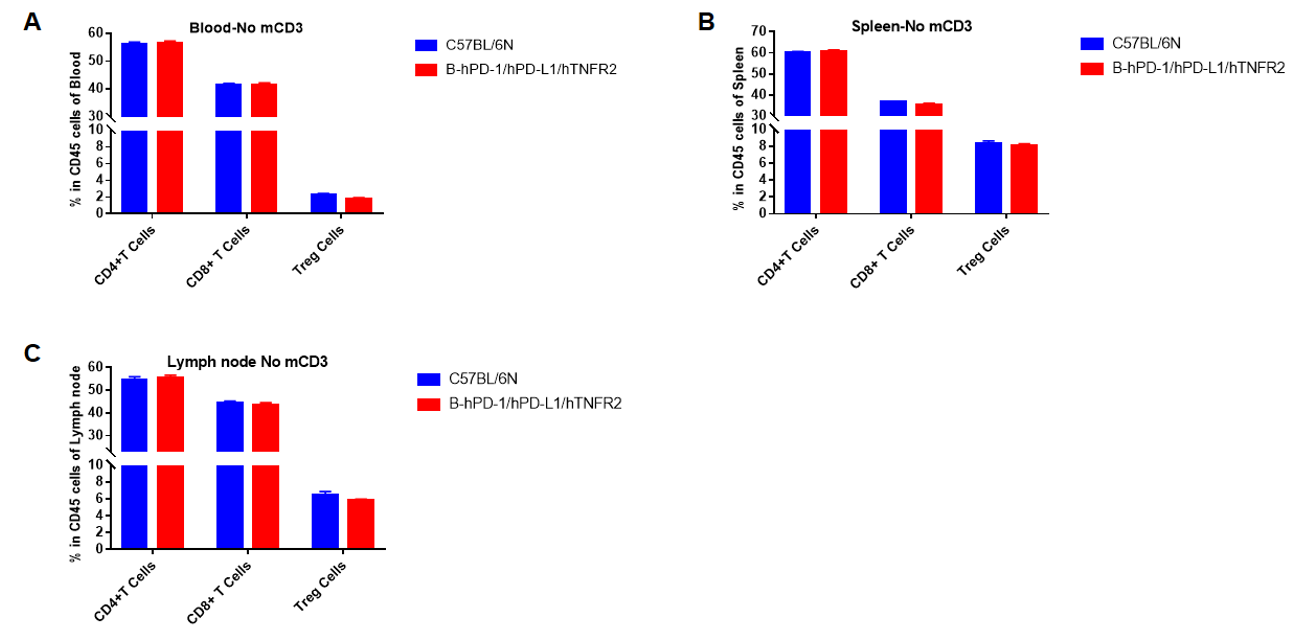
Analysis of blood, spleen and lymph node T cell subpopulations by FACS
Blood, spleen and lymph node leukocytes cell were isolated from female mice in the panel(n=3, 6 week-old). Flow cytometry analysis was performed to assess leukocyte subpopulations. Percent of CD4+T, CD8+T and Tre cells in homozygous B-hPD-1/hPD-L1/hTNFR2 mice were similar to those in the C57BL/6 mice, demonstrating that the humanized mouse does not change the overall development, differentiation or distribution of these cell types in blood, spleen and lymph node.
-
Blood Chemistry

-
Blood routine test of B-hPD-1/hPD-L1/hTNFR2 mice
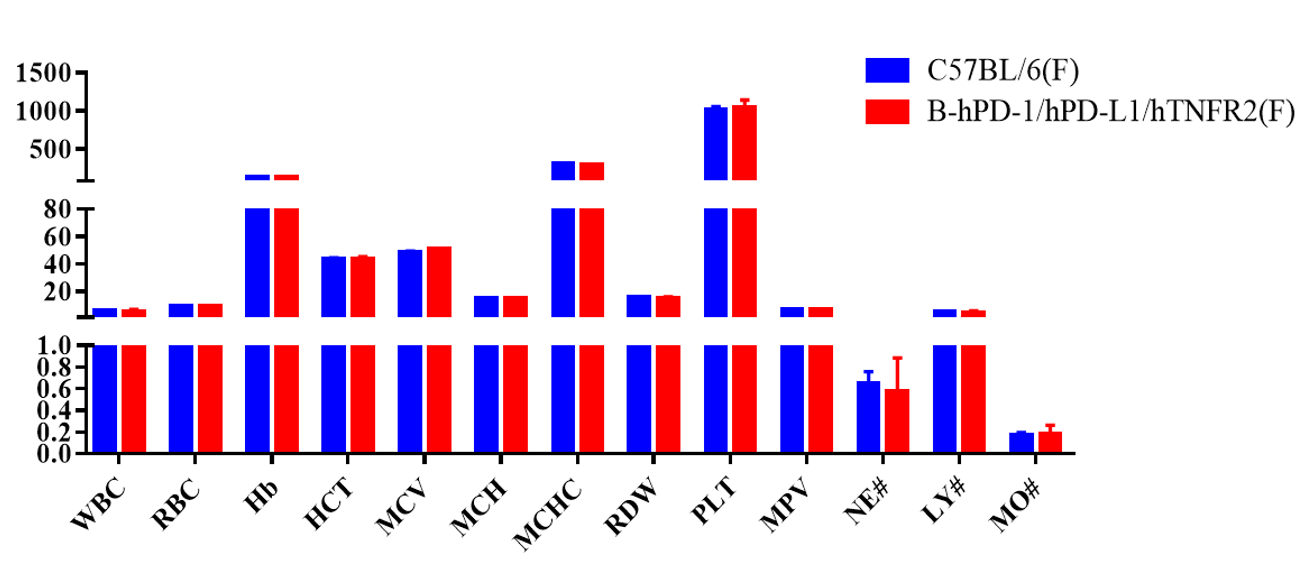
Complete blood count (CBC). Blood from C57BL/6 and B-hPD-1/hPD-L1/hTNFR2 mice (n=5, 6 week-old, female) were collected and analyzed for CBC. Any measurement of B-hPD-1/hPD-L1/hTNFR2 mice in the panel were similar to C57BL/6, indicating that humanized mouse does not change blood cell composition and morphology. Values are expressed as mean ± SEM.
Blood chemistry of B-hPD-1/hPD-L1/hTNFR2 mice

Blood chemistry tests of B-hPD-1/hPD-L1/hTNFR2 mice. Serum from C57BL/6 and B-hPD-1/hPD-L1/hTNFR2 mice (n=5, 6 week-old, female) were collected and analyzed for levels of ALT, AST and other indicators in the panel. There was no differences on either measurement between C57BL/6 and humanized mouse, indicating that humanized mouse does not change ALT and AST levels or health of liver. Values are expressed as mean ± SEM.
-
Combination Therapy

-
Combination therapy of anti-human PD-1 and anti-human TNFR2 antibody
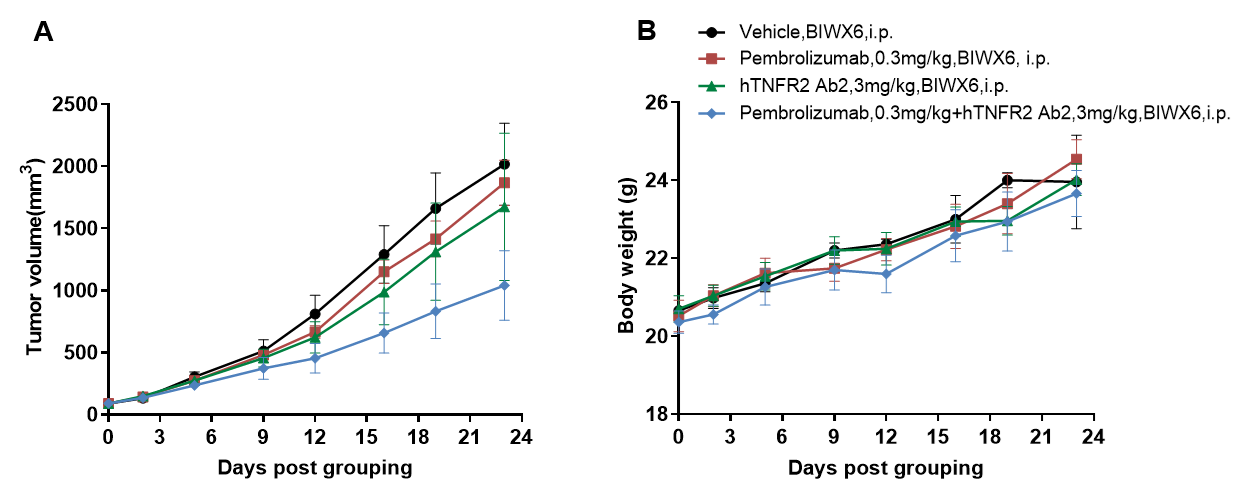
Antitumor activity of anti-human PD-1 antibody combined with anti-human TNFR2 antibody in B-hPD-1/hPD-L1/hTNFR2 mice. (A) Anti-human PD-1 antibody combined with anti-human TNFR2 antibody inhibited hPD-L1 MC38 tumor growth B-hPD-1/hPD-L1/hTNFR2 mice. All antibodies used in the experiments were prepared in-house. hPD-L1 MC38 cells were subcutaneously implanted into homozygous B-hPD-1/hPD-L1/hTNFR2 mice (female, 6-7-week-old, n=5). Mice were grouped when tumor volume reached approximately 100 mm3, at which time they were treated with human PD-1 antibody and human hTNFR2 antibodies (in house) with doses and schedules indicated in panel A. (B) Body weight changes during treatment. As shown in panel A, combination of PD-1 and hTNFR2 antibodies shows more inhibitory effects than individual groups, demonstrating that B-hPD-1/hPD-L1/hTNFR2 mice provide a powerful preclinical model for in vivo evaluating combination therapy efficacy of hTNFR2 antibodies and hPD-1 antibodies. Values are expressed as mean ± SEM.


